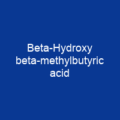Understanding β-Hydroxy β-methylbutyric Acid (HMB): A Key Player in Muscle Health
HMB, or β-hydroxy β-methylbutyric acid, is a naturally occurring substance that has gained significant attention for its potential benefits in muscle health and recovery. But what exactly does HMB do, and why should you care about it? Let’s dive into the fascinating world of this compound.
The Role of HMB in Muscle Health
Imagine your muscles as a fortress under siege—HMB acts like a valiant knight, defending against the enemy (protein breakdown) while also building up the walls (muscle protein synthesis). This dual action makes HMB an essential ally for anyone looking to enhance their muscle health.
How Does HMB Work?
HMB works by stimulating myofibrillar muscle protein synthesis and inhibiting muscle protein breakdown. It does this through various mechanisms, including the activation of mechanistic target of rapamycin complex 1 (mTORC1) and inhibition of proteasome-mediated proteolysis in skeletal muscles.
The Science Behind HMB
HMB is synthesized from L-leucine metabolism through a series of enzyme-catalyzed reactions. During biotin deficiency, MC-CoA (a metabolite) is converted to HMB-CoA by enoyl-CoA hydratase and an unknown thioesterase enzyme. In healthy individuals, α-KIC (another metabolite) is transformed into HMB via 4-hydroxyphenylpyruvate dioxygenase.
Supplementation and Its Benefits
When it comes to supplementation, the effects of HMB are more pronounced in untrained individuals and athletes who perform high-intensity resistance or aerobic exercise. For instance, with an appropriate exercise program, dietary supplementation with 3 grams of HMB per day can increase muscle size, strength, power, lean body mass, reduce skeletal muscle damage, and expedite recovery from high-intensity exercise.
Timing is Key
The timing of HMB intake relative to exercise plays a crucial role in its effectiveness. For instance, ingesting 1–2 hours prior to exercise or 30–60 minutes before can significantly reduce skeletal muscle damage from a single bout of exercise.
Safety and Efficacy
The safety profile of HMB is well-established. In humans, no adverse effects have been reported when taken in doses of 3 grams per day for up to a year. However, pregnant and lactating women are advised not to take HMB due to limited safety studies.
Pharmacodynamics and Pharmacokinetics
HMB is metabolized within skeletal muscle into cholesterol, which enhances membrane integrity and function. Its effects on muscle protein metabolism help stabilize muscle cell structure. The concentration of HMB in body fluids varies widely, with the highest levels found in intramuscular fluid.
Historical Context
The first reported chemical synthesis of HMB was published in 1877 by Michael and Alexander Zaytsev, while it was isolated from the bark of Erythrophleum couminga in 1941 by Leopold Ružička. The effects on human skeletal muscle were discovered by Steven L. Nissen in the mid-1990s.
Conclusion
HMB is a powerful ally in your quest for better muscle health and recovery. Whether you’re an athlete, a fitness enthusiast, or simply someone looking to maintain optimal muscle function, understanding HMB can be a game-changer. So, why not give it a try and see the difference it can make?

You want to know more about Β-Hydroxy β-methylbutyric acid?
This page is based on the article Β-Hydroxy β-methylbutyric acid published in Wikipedia (retrieved on March 11, 2025) and was automatically summarized using artificial intelligence.






